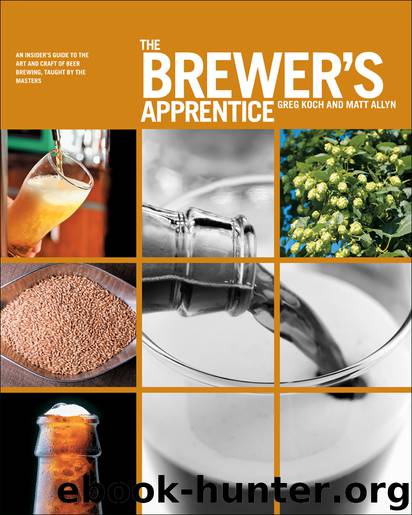The Brewer's Apprentice by Greg Koch

Author:Greg Koch
Language: eng
Format: epub, mobi
Publisher: Rockport Publishers
Published: 2011-08-23T16:00:00+00:00
At Denver’s Wynkoop Brewing, a brewer adds roasted pumpkin to the mash. Homebrewers should use smaller chunks to compensate for a smaller system.
CHERRIES AND MANGOS
These both have milder flavors. To have an effect on the final brew, you will need to add as much as 2 pounds per gallon (240 g per liter).
BLUEBERRIES AND STRAWBERRIES
These require similarly high dosing along with a lighter base beer: Add as much as 2 pounds per gallon (240 g per liter). When brewing with lighter-tasting fruits, it’s best to work with lower hopping rates.
CITRUS
Citrus fruits make a delicious complement to American hops. When brewing with them, all you want of the fruit is the peel and zest to use as a spice. Sour oranges, such as Seville, work well, as do tangerines and grapefruit. The zest or peel of one orange added at the end of a boil will add a basic citrus character to your brew.
FORMS OF FRUIT
If you’re not brewing with whole fruit, you will need to adjust your dosing. Fruit purées do not contain seeds, making them about 10 percent more potent (10 ounces, or 280 g, of purée is 11 ounces, or 310 g, of fruit). Juice is even more potent, though the final flavor depends heavily on the quality of juice (look for farm-fresh instead of sweetened and pasteurized). A juice concentrate needs anywhere from 2 to 6 ounces per gallon (15 to 45 g per liter) to impart flavor. Read the concentrate label for its fruit equivalent to plan a more accurate addition.
Download
This site does not store any files on its server. We only index and link to content provided by other sites. Please contact the content providers to delete copyright contents if any and email us, we'll remove relevant links or contents immediately.
| Beer | Cocktails & Mixed Drinks |
| Coffee & Tea | Homebrewing, Distilling & Wine Making |
| Juices & Smoothies | Wine & Spirits |
101 Whiskies to Try Before You Die by Ian Buxton(44788)
World's Best Whiskies by Dominic Roskrow(44730)
Whiskies Galore by Ian Buxton(41864)
Craft Beer for the Homebrewer by Michael Agnew(18140)
Right Here, Right Now by Georgia Beers(4122)
Not a Diet Book by James Smith(3335)
Water by Ian Miller(3126)
The Coffee Dictionary by Maxwell Colonna-Dashwood(3062)
Kitchen confidential by Anthony Bourdain(3006)
Coffee for One by KJ Fallon(2559)
Smuggler's Cove: Exotic Cocktails, Rum, and the Cult of Tiki by Martin Cate & Rebecca Cate(2468)
Superfood Smoothie Bowls: Delicious, Satisfying, Protein-Packed Blends that Boost Energy and Burn Fat by Chace Daniella(2387)
Talking as Fast as I Can by Lauren Graham(2379)
Beer is proof God loves us by Charles W. Bamforth(2368)
Bourbon: A Savor the South Cookbook by Kathleen Purvis(2244)
A Short History of Drunkenness by Forsyth Mark(2233)
Eat With Intention by Cassandra Bodzak(2154)
Cocktails for the Holidays by Editors of Imbibe magazine(2079)
Colombia Travel Guide by Lonely Planet(2060)
